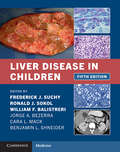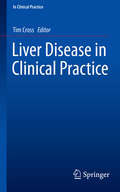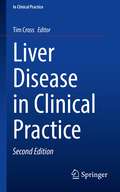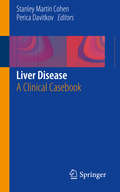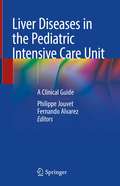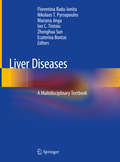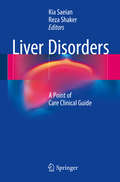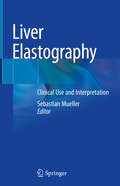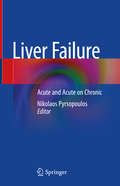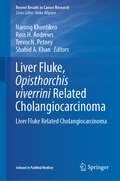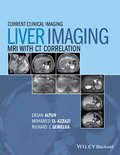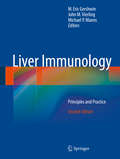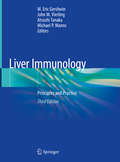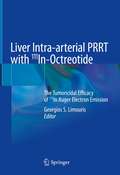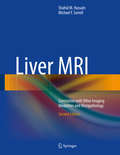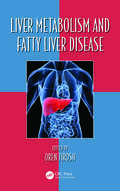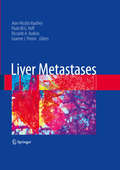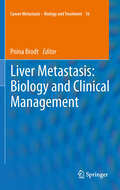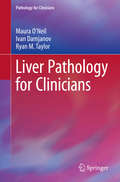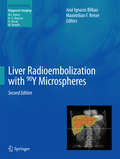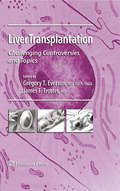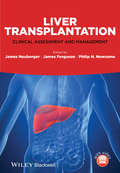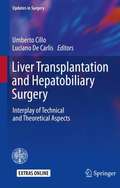- Table View
- List View
Liver Disease in Children
by Jorge A. Bezerra Cara L. Mack Benjamin L. ShneiderLiver disease in children is increasing in prevalence, placing a huge burden on healthcare systems and often requiring long-term management. Offering an integrative approach to the science and clinical practice of pediatric hepatology, this is the definitive reference text for improved diagnosis and treatment strategies. In the new edition of this authoritative text, chapters have been thoroughly revised in line with major advances in the field, such as recognizing the increased frequency of fatty liver disease, and how genetic testing has the potential to establish earlier diagnoses for a variety of diseases. Disorders covered include cholestasis, metabolic disorders and hepatitis, with their presentation across the spectrum of infancy, childhood and adolescence discussed. The indications and surgical aspects of liver transplant are explained and post-transplant care is described in detail. This is a valuable resource for pediatricians, hepatologists, gastroenterologists and all clinicians involved in the care of children with liver diseases.
Liver Disease in Children
by Frederick J. Suchy William F. Balistreri Ronald J. Sokol MD Ronald J. SokolCompletely revised new edition of the premier reference on pediatric liver disease. Liver Disease in Children, 3rd Edition provides authoritative coverage of every aspect of liver disease affecting infants, children, and adolescents. Chapters are written by international experts and address the unique pathophysiology, manifestations, and management of these disorders in the pediatric population. The third edition has been thoroughly updated and features new contributions on liver development, cholestatic and autoimmune disorders, fatty liver disease, and inborn errors of metabolism. An essential resource for all physicians involved in the care of children with liver disease.
Liver Disease in Children (3rd Edition)
by Frederick J. Suchy William F. Balistreri Ronald J. SokolCompletely revised new edition of the premier reference on pediatric liver disease. Liver Disease in Children, 3rd Edition provides authoritative coverage of every aspect of liver disease affecting infants, children, and adolescents.
Liver Disease in Clinical Practice
by Tim CrossThis pocket guide covers the common manifestations of liver disease, how to treat them and when to refer patients on to specialist centers. The book outlines the common clinical liver diseases such as fatty liver disease and hepatitis, among others, and their current up to date management. Written by experts in the field and containing figures and tables, as well as case histories and questions, this is an enjoyable and reader-friendly book for the busy physician. With its authoritative, didactic style and short chapters, it covers the common presentations and complications of liver disease, and how to deal with them. Given the increasing prevalence of liver disease in the UK and throughout Western Europe, this is an ideal reference book for primary care physicians, doctors in specialist training, clinical nurse specialists and for gastroenterologists, who see patients with liver disease in their working lives.
Liver Disease in Clinical Practice (In Clinical Practice)
by Tim CrossThe new edition of this pocket guide has been fully updated to cover the common manifestations of liver disease, how to treat them and when to refer patients on to specialist centers. New chapters on Acute Liver Failure, Nutrition and Congenital Heart Disease have been added to reflect the key issues in management of liver diseases. The book outlines the common clinical liver diseases such as fatty liver disease and viral hepatitis, among others, and their current up to date management. Written by experts in the field and containing figures and tables, as well as case histories and questions, this is an enjoyable and reader-friendly book for the busy physician. With its authoritative, didactic style and short chapters, it covers the common presentations and complications of liver disease, and how to deal with them. Given the increasing prevalence of liver disease in the UK and Worldwide, this is an ideal reference book for primary care physicians, doctors in specialist training, clinical nurse specialists and for gastroenterologists, who see patients with liver disease in their working lives.
Liver Disease: A Clinical Casebook
by Stanley Martin Cohen Perica DavitkovThis clinical casebook provides a concise yet comprehensive state-of-the-art review of liver disease. Presented in a case-based format, each case features a scenario centered on a different variant of liver disease, with sections on case history, diagnosis/assessment, treatment, outcomes, alternative approaches, and clinical pearls. Diseases covered include drug-induced liver injury, acute hepatitis, chronic hepatitis, NAFLD, and cholangitis. Scenarios such as liver disease in pregnancy, elevated liver function tests, and liver transplants are also presented in the casebook.Written by experts in the field, Liver Disease: A Clinical Casebook is a valuable resource for clinicians and practitioners who treat patients with liver disease.
Liver Diseases in the Pediatric Intensive Care Unit: A Clinical Guide
by Fernando Alvarez Philippe JouvetIn recent years, substantial progress has been made in the approaches to diagnosis and treatment of severe liver diseases in the pediatric ICU, from various forms of liver failure and hepatitis to acute and chronic liver disease. New techniques and tools are being utilized to prevent patients from experiencing complications and for patients in recovery from operations on the native or donor liver. This book describes the clinical presentation and management of liver diseases in the intensive care unit with the pediatric patient in mind. In addition, advances in bone marrow transplantation, cardiac-generated liver disorders and new therapeutic approaches, such as artificial liver support, are discussed in detail. Presenting the current available knowledge in a compelling form, Liver Diseases in the Pediatric Intensive Care Unit is a valuable resource for pediatric gastroenterologists and hepatologists, pediatricians and intensivists.
Liver Diseases: A Multidisciplinary Textbook (The\clinics: Internal Medicine Ser. #22-2)
by Florentina Radu-Ionita Nikolaos T. Pyrsopoulos Mariana Jinga Ion C. Tintoiu Zhonghua Sun Ecaterina BontasThis book provides an in-depth coverage not only of liver pathology but also of diagnosis of the numerous types of liver disease, placing specific emphasis on current treatments of liver pathology including the most up-to-date information on liver transplantation. The first part of provides an in-depth account of the liver pathology in different conditions such as Hepatits, liver ischaemia reperfusion injury, Lyme disease, cirrhotic cardiomyopathy and hepatocellular carcinoma. The second part provides a comprehensive overview of diagnostic methods. Of particular interest are chapters on the latest techniques in Patient-specific 3D printing and transient elastography (FibroScan). The final part focuses on treatment and provides a step-by step guide to the therapeutic management of liver diseases starting with pharmacological treatment and techniques including surgery and liver transplantation. This is an invaluable book for clinicians, practitioners including academics, scientists/researchers and postgraduates to provide the newest knowledge in the field of liver pathogenesis. It is written by a multidisciplinary team of experts in hepathology, gastroenterology, and surgery especially from liver transplantation.
Liver Disorders
by Reza Shaker Kia SaeianThis book is a comprehensive and easy-to-access guide not only in the diagnosis of the various types of liver disease but in the management of specific disorders, including the particular nuances of the care of the patient with liver disease. It provides a resource to the practitioner caring for patients with liver disease for addressing everyday questions posed by patients and their families, as well as referring physicians, in a manner that can easily be conveyed. The spectrum covered includes appropriate testing and disease monitoring of patients, use of medications, supplements, alternative therapies and alcohol, operative risk assessment, implementation of health maintenance for patients with chronic liver disease and cirrhosis, identification and management of particular complications of cirrhosis, and appropriate referral for liver transplantation, as well as management of special populations. Written by experts in the field, Liver Disorders: A Point of Care Clinical Guide is a valuable resource for clinicians who treat patients with a variety of liver disorders.
Liver Elastography: Clinical Use and Interpretation
by Sebastian MuellerThis is the first comprehensive book on the new elastographic techniques discussing the early assessment of liver fibrosis. The book covers all aspects of measuring liver stiffness starting from the methodology, the molecular basis of liver stiffness elevation up to current clinical algorithms and interpretation. Future directions and novel implications that go beyond diagnosis but are relevant for understanding of liver cirrhosis per se are also discussed in detail. Liver Elastography, is an essential companion for hepatologists and gastroenterologists that provides an overview of its basic principles and gives a detailed account of how to use elastrography in clinical practice.
Liver Failure: Acute and Acute on Chronic (The\clinics: Internal Medicine Ser. #22-2)
by Nikolaos PyrsopoulosThis book offers a comprehensive overview of liver failure including Epidemiology, mechanism of the disease, and its clinical manifestations. The diagnosis of numerous types of liver disease leading to liver failure; with specific emphasis on the current and future treatment modalities including up-to-date and extensive information on liver transplantation. It provides the most up-to-date information on liver failure for clinicians, practitioners including GPs, scientists/researchers, postgraduates and allied health professionals. It features an overview of the relevant classification and epidemiologic aspects of acute liver failure along with a thorough review of the mechanisms associated with acute liver failure and multisystemic involvement. Detailed guidance is also provided on the latest treatment techniques including those available for liver transplantation and potential future approaches, enabling the reader to develop a detailed understanding of the topic. Liver Failure: Acute and Acute on Chronic provides a practically applicable guide to the epidemiology and management of liver failure. It features contributions from an outstanding panel of experts in hepatology, gastroenterology and surgery making it a vital up-to-date reference for trainee and practicing medical professionals in a variety of disciplines who encounter these patients.
Liver Fluke, Opisthorchis viverrini Related Cholangiocarcinoma: Liver Fluke Related Cholangiocarcinoma (Recent Results in Cancer Research #219)
by Trevor N. Petney Narong Khuntikeo Ross H. Andrews Shahid A. KhanThis volume discusses new developments in the etiology, diagnosis, and treatment of cholangiocarcinoma induced by the liver fluke Opisthorchis viverrini. Although cholangiocarcinoma is rare in the Western world, it has a very high incidence in continental Southeast Asian countries, where it is linked to infection with O. viverrini. In Southeast Asia this cancer causes thousands of deaths every year and places a severe socioeconomic burden on the affected families. Diagnosis is usually at a late disease stage, and in the past palliative surgery and care have been the major therapeutic options. Recently, however, techniques have become available for early-stage diagnosis that offer the possibility of curative surgery, and novel chemotherapeutic options are also under development. In Thailand alone, more than 2 million individuals have now been registered for screening for this cancer. The aim of this book is to highlight the latest research in the field and to explain how the newly available techniques can be applied to reduce the risk of developing cholangiocarcinoma and increase the likelihood of survival.
Liver Imaging
by Richard C. Semelka Mohamed El-Azzazi Ersan AltunThe first single source work to deal with the two primary radiologic modalities in diagnosing and treating benign and malignant diseases of the liver, presented with clearly laid out MRI and CT correlations. Developed by an editor team led by one of the world's leading authorities in abdominal imaging, Richard C. Semelka MD. User-friendly, atlas-style presentation, with over 1500 MRI and CT images in over 320 figures featuring state-of-the-art MR and CT imaging sequences, multidetector row CT images, 3D reformatted images, breath-hold MRI sequences, and cutting-edge MR 3T images Highly practical approach for imaging of focal and diffuse liver lesions, complete relevant and systematic (differential) diagnostic information, the latest references to primary literature and clinical evidence, and patient management possibilities Reflects a pattern-recognition approach to MRI and CT imaging, assisting with efficient scanning of images and assessment and diagnosis of disorders
Liver Immunology
by M. Eric Gershwin Michael P. Manns John M. VierlingLiver Immunology: Principles and Practice, Second Edition begins with important information about the epidemiology and mortality of liver disease worldwide. This information is followed by chapters related to basic immunology, application of liver immunology for diagnosis, and several excellent chapters that provide a solid foundation for understanding immune-mediated liver disease, including those associated with the biliary tree. A chapter on non-hepatic manifestations of immune mediated liver disease helps provide context for how these diseases affect the patient overall. In addition, chapters discuss various discrete immunologically-mediated infectious liver disorders including those related to bacteria, parasites, and all of the classic viruses. Chapters on the traditional autoimmune liver diseases -- primary biliary cirrhosis, autoimmune hepatitis, primary sclerosing cholangitis as well as overlap syndrome - are also included. The breadth of this comprehensive second edition is highlighted by chapters on alcoholic liver disease, non-alcoholic fatty liver disease, and drug-induced liver disease, among others. This invaluable new edition ends with a forward-looking view of future directions and how the field might meet the challenge of refractory patients. Developed by a renowned group of authors, Liver Immunology: Principles and Practice, Second Edition will again serve as a comprehensive textbook by providing an excellent overview for this rapidly evolving field. It greatly adds to the understanding of the pathogenesis of these diseases, while also providing novel insights that can be harnessed into helping improve the care of patients afflicted with various immune-mediated diseases. This volume will again be a must-read for clinicians at all levels, investigators and students.
Liver Immunology: Principles and Practice
by M. Eric Gershwin Michael P. Manns John M. Vierling Atsushi TanakaThe third edition of this acclaimed work provides clinicians and investigators with a wealth of state-of-the-art information that will lead to fresh approaches in thinking about liver physiology and liver diseases. Developed by a panel of renowned international authors, this edition outlines a range of important advances in our understanding of the liver’s role as an immune organ and the functions of innate and adaptive immunity in the pathogenesis of all liver diseases. Indeed, the liver is a vitally important immune organ producing liver-derived products that can trigger the innate and adaptive immune system to initiate, mediate, regulate, and resolve systemic inflammation. The book begins with an analysis of the core concepts of immunology, including the definition of autoimmunity and its unique application to the liver, a tolerogenic organ. Subsequent chapters then explore the biological elements of liver diseases caused by epigenetics, genetics, and innate and adaptive immunity. Specific clinical presentations and aspects of liver diseases are also examined, such as Hepatitis C, non-alcoholic fatty liver disease and parasitic infections. Closing chapters then discuss liver diseases among specific populations, including pediatrics, those with comorbidities and preexisting conditions, pregnant women, and finally patients with transplanted organs. A timely and invaluable update to the clinical literature, Liver Immunology: Principles and Practice, Third Edition, is once again a comprehensive work that will not only enhance the understanding of liver diseases but also provide the kind of novel insights that greatly accelerates the evidence-based care of children and adults afflicted with these diseases. This volume is again a must-read for clinicians at all levels, for investigators and for students.
Liver Intra-arterial PRRT with 111In-Octreotide: The Tumoricidal Efficacy of 111In Auger Electron Emission
by Georgios S. LimourisThis book describes in detail a clinical project that reveals the tumoricidal efficacy of Auger and internal conversion electrons, emitted from n.c.a. 111In and implemented in oncology as a treating armamentarium for peptide receptor radionuclide therapy (PRRT), targeting small size (ø ≤ 20 mm) tumors and micro-metastases.The keen interest in n.c.a. 111In began when it was observed that its Auger electron emission could be highly radiotoxic, due to its high LET when it decayed in the vicinity of cellular DNA. The somatostatin analog octreotide, labeled with [111In-diethylenetriaminepentaacetic acid (DTPA0-D-Phe1)] is an established diagnostic agent for the imaging of somatostatin receptor-positive neuro- (or non-neuro) endocrine tumors. It relies on receptor-mediated binding, internalization and installation in the lysosomes in the proximity of the nucleus; administered in large doses, loco-regionally, via the feeding artery of solid tumors, can be highly radiotoxic if they over-express somatostatin receptors, mainly of the sst2 histotype.The book compares the results between i.v. and i.a. implementation in more than 80 patients after over 800 i.a. infusions in neuroendocrine tumors, meningiomas, paragangliomas and colorectal carcinomas in a single Institute (Aretaieion University Hospital) and encourages the i.a. way, leading to “tumor melting”, while minimizing the toxicity to healthy peritumoral liver tissue and critical organs (kidneys and bone marrow).The volume is an invaluable tool for nuclear medicine physicians, interventional radiologists and oncologists dealing with radiopeptide therapies.
Liver MRI
by Michael F. Sorrell Shahid M. HussainThe second edition of this very successful book provides a practical approach to liver MRI, with coverage of the most up-to-date MR imaging sequences, normal and variant anatomy and diverse pathologic conditions. It features computer-generated drawings relating clinical concepts to the MRI findings, 2D and 3D reconstructions, systematic (differential) diagnostic information and descriptions of patient management options. MRI findings are correlated to ultrasound, computed tomography, nuclear medicine exams, laboratory findings and histopathology when appropriate. New information is presented on a wide range of topics and more than 50 extra figure pages are included. This book will greatly benefit all professionals interested and involved in imaging, diagnosis and treatment of focal and diffuse liver lesions, including radiologists, gastroenterologists, hepatologists, surgeons, pathologists, MR physicists, radiology and other residents, MR technologists and medical students. p>
Liver Metabolism and Fatty Liver Disease (Oxidative Stress and Disease #34)
by Oren TiroshAbout 30% of the general population suffers from Non-Alcoholic Fatty Liver Disease, and the incidence of more serious fatty liver disorders increases with obesity. This discusses the current understanding of development of liver disease and the clinical aspects of fatty liver disease by examining the current knowledge regarding the absorption, metabolism of fat in the liver. It summarizes the current knowledge regarding the involvement of oxidative stress, the metabolic effects inflammation, and the effect of nutrition in the disease development and progression.
Liver Metastases
by Riccardo A. Audisio Paulo M. Hoff Jean-Nicolas Vauthey Graeme J. PostonThis book addresses the contemporary multidisciplinary management of liver metastases. Throughout the text, experience from the paradigms of colorectal cancer metastases treatment strategies are used to point to new directions in the management of liver metastases from other cancers. The book will be invaluable for surgeons in general surgery, hepatobiliary surgery, upper GI surgery, colorectal surgery, medical and clinical oncologists with an interest in liver tumours, and radiologists with an interest in liver disease.
Liver Metastasis: Biology and Clinical Management
by Pnina BrodtLiver metastases are a frequent and often fatal occurrence in cancer patients, particularly those with malignancies of the gastrointestinal (GI) tract. While recent improvements in surgical techniques and a more aggressive approach to resection of liver metastases have improved long term survival for some patients, most patients with hepatic metastases still succumb to their disease. To improve these dismal statistics, a better understanding of the biology of liver metastasis, particularly the early stages that can be targeted for prevention, is essential. Once cancer cells enter the liver, several different scenarios may occur. The cancer cells may be immediately destroyed by local defence mechanisms, they may enter a state of dormancy as solitary cells and never produce a metastasis, initiate a short-lived process of proliferation that is aborted before a metastasis is established or actively proliferate to form macrometastases. The chapters in Part I of this book provide insight into the cellular/molecular mechanisms that determine which of these scenarios prevails. Written by experts researchers in the filed of metastasis, these chapters provide state-of-the art reviews on the cellular and molecular processes that impact the early stages of the metastatic process. The unique microenvironment of the liver, its various anatomical, cellular and molecular features and the impact they have on metastasis are highlighted. In addition, the role of inflammation (pre-existing and tumor-induced), host innate and adaptive immune responses, cytokines, chemokines, growth factors and the unique molecular signatures of metastatic tumor cells are reviewed with an underscoring of the translational implications of the current state of knowledge. Against this background, the chapters in Part II of the book provide critical reviews on major aspects of the clinical management of hepatic metastases. These include imaging strategies, surgical and chemotherapeutic treatment approaches and the use of targeted biological therapeutics such as anti-angiogenic drugs as treatment modalities. By combining information on biological and clinical aspects of liver metastasis, this volume will serve as an excellent resource for scientists, clinicians, clinician/ scientists and trainees in the domains of oncology, surgical oncology, hepatobiliary physiology and radiology.
Liver Pathology for Clinicians
by Maura O'Neil Ivan Damjanov Ryan M. TaylorThis is the first volume in a new Springer series, Pathology for Clinicians, which aims to assist clinicians in their daily decision making by providing reliable, clearly presented information on current techniques in pathology, their uses and indications, clinical-pathologic correlations, and the significance of pathologic diagnoses. Liver Pathology for Clinicians first discusses key technical aspects of liver biopsy, including the use of special stains and immunohistochemistry. Detailed guidance is provided on both common and uncommon indications for liver biopsy, including repeat or serial biopsies, and on the choice of procedure. The role of liver biopsy in the contexts of transplantation and systemic disease is also clearly explained. Clinical-pathologic correlations are presented with the aid of high-quality illustrations.
Liver Radioembolization with 90Y Microspheres
by José Ignacio Bilbao Maximilian F. ReiserThis is the second edition of a very well received book devoted specifically to the treatment of liver tumors by radioembolization with 90Y microspheres. The success of the first edition was based on the provision of all the fundamental information required for successful use of this therapeutic modality in clinical practice. The new edition has been fully updated to cover the most recent advances and includes additional chapters on regulations and emerging trends. Detailed information is provided on the full range of relevant topics, including hepatic vascular anatomy (including variants), dosimetry, assessment of tumor response, and the results achieved using radioembolization alone and in combination with other treatments in patients with primary or metastatic disease. Complications and side-effects are also fully discussed. This book will prove immensely valuable for both beginners and practitioners.
Liver Transplantation
by Gregory T. Everson James F. TrotterThe field of liver transplantation is young, evolving, dynamic, and issues and decisions are often controversial, thus a text with a different focus is required, one that highlights controversy and challenges dogma. In Liver Transplantation: Challenging Controversies and Topics a useful set of chapters have been created that will take the reader step-by-step through key areas of controversy in the field of liver transplantation. The authors have tried to anticipate questions, define key issues, and provide options for resolving or approaching areas of uncertainty. The topics covered in this book impact our understanding and management of immunosuppressant, viral hepatitis, nonalcoholic fatty liver disease, organ allocation, regional differences in rates of transplantation, and hepatocellular cancer. All authors are actively practicing physicians and surgeons who deal with all the issues presented on an ongoing and daily basis. Throughout the book, emphasis is put on the need for thoughtful well-controlled clinical and basic research of transplant hepatology and liver transplantation. There is also speculation on potential breakthroughs in immunology, virology, cell biology, surgery and medicine that might influence or impact the future directions of these fields of medicine. Liver Transplantation: Challenging Controversies and Topics is an important new book meant to stimulate interest, identify topics requiring additional study, and to promote discourse among transplant professionals.
Liver Transplantation
by James Ferguson James Neuberger Philip N. NewsomeLiver Transplantation: Clinical Assessment and Management is the perfect tool for all gastroenterologists, hepatologists and transplant surgeons managing patients with liver disease awaiting and undergoing transplantation. Led by James Neuberger, world experts in hepatology and transplantation provide a chronological, step-by-step approach to best clinical management and patient care. Evidence-based throughout and with reference to the very latest practice guidelines from major societies such as EASL and AASLD, the book covers:When to refer a patient for liver transplantationSelection, assessment and management on the listTransplantation for acute liver failureDonation and allocationCare of the liver transplant recipient80 high definition videos of transplant surgery allow you to watch the experts in action and provide an outstanding visual and teaching element. In addition, key points, potential pitfalls, management algorithms, and useful weblinks all help ensure rapid reference browsing. If you're managing patients requiring a liver transplant, this multimedia resource will save you time and effort by putting essential information within easy reach.
Liver Transplantation and Hepatobiliary Surgery: Interplay of Technical and Theoretical Aspects (Updates in Surgery)
by Luciano De Carlis Umberto CilloIn the past, liver resections and liver transplantations were performed by different surgical teams, with very little interplay between the two. However, the evolution toward more complex operations called for an increasingly intense interaction between these surgical techniques: split liver and living donor liver transplantation have become popular in the transplant community, utilizing the Coinaud segmental anatomy in a very sophisticated way, while portal and arterial resection and reconstruction have become indispensable methods for treating Klatskin tumors infiltrating the hepatic hilum. This book offers a complete overview of the connections between liver transplantation and hepatobiliary surgery. It focuses on ex situ techniques for resection of tumors at the suprahepatic confluence, with or without venous reconstruction, and on total vascular exclusion of the liver with the aid of a venovenous bypass that should be a surgical option for referral centers in hepatopancreatobiliary surgery. By taking into consideration the development of minimally invasive liver surgery, it will introduce readers to a variety of new perspectives such as: vascular exclusion techniques with or without extracorporeal circulation, hemodynamic implications and lessons learned from liver transplant surgery, and technical details on pediatric transplantation and its informative role in modern biliary tract surgery.
